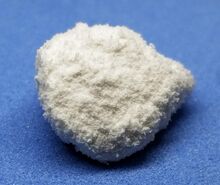Chemistry:Octyl gallate
From HandWiki

| |

| |

| |
| Names | |
|---|---|
| Preferred IUPAC name
Octyl 3,4,5-trihydroxybenzoate | |
| Other names
E311; Progallin O; n-Ocyl gallate; Stabilizer GA-8; Gallic acid octyl ester; 3,4,5-Trihydroxybenzoic acid octyl ester
| |
| Identifiers | |
3D model (JSmol)
|
|
| ChEBI | |
| ChEMBL | |
| ChemSpider | |
| EC Number |
|
PubChem CID
|
|
| UNII | |
| |
| |
| Properties | |
| C15H22O5 | |
| Molar mass | 282.336 g·mol−1 |
| Appearance | White solid[1] |
| Melting point | 98 to 101 °C (208 to 214 °F; 371 to 374 K)[1] |
| Hazards | |
| GHS pictograms | 
|
| GHS Signal word | Warning |
| H302, H317 | |
| P261, P264, P270, P272, P280, P301+312, P302+352, P321, P330, P333+313, P363, P501 | |
Except where otherwise noted, data are given for materials in their standard state (at 25 °C [77 °F], 100 kPa). | |
| Infobox references | |
Tracking categories (test):
Octyl gallate is the ester of 1-octanol and gallic acid. As a food additive, it is used under the E number E311 as an antioxidant and preservative.
Properties
Octyl gallate is a white powder with a characteristic odor. It is very slightly soluble in water and soluble in alcohol. Its solubility in lard is 1.1%. Octyl gallate darkens in the presence of iron.
Uses
This antioxidant is used in numerous pharmaceutical, cosmetic, and food products; such as soaps, shampoos, shaving soaps, skin lotions, deodorants, margarine, and peanut butter.
It is a synergistic antioxidant with butylated hydroxytoluene (BHT) and butylated hydroxyanisole (BHA).
References
- ↑ 1.0 1.1 Octyl gallate at chemicalland21.com
 |

